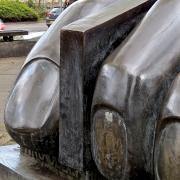
Last month, in Issue 245, John Ross Maclean's first article about the ‘Big Foot’ cluster of sculptures at the top of Broughton Street prompted a reader's letter.
The communication provided interesting supplementary detail about the pieces, and was from a very eminent authority on Paolozzi’s work who prefers to remain anonymous.
We reproduce a lightly redacted version of the main points here.
So glad to see your feature on the 1991 ‘Manuscript of Monte Cassino’ by Sir Eduardo Paolozzi, funded by Sir Tom Farmer.
There is a bronze plaque on the kerb of the flowerbed, giving the text and translation. Inside the flowerbed are fragments of masonry from Leith Central Station.
I see the foot as the traveller and the hand as the hospitality of the monks. The copulating insects can be seen in the Paolozzi studio at Gallery of Modern Art Two (Dean Gallery) as can the globes also on the hand. They derive from a sculpture Paolozzi made for the Alte Pinacothek in Munich called ‘For Leonardo’, and derive from a magazine diagram about DNA (sculpture unveiled 1986).
The Italian community in Edinburgh had a club in Picardy Place in the 1930s and it could be that another function of the sculpture is to commemorate all the Italians drowned on the SS Arandora Star when it was sunk. These included Paolozzi’s father Alfonso and his maternal Rossi grandfather.

As with all public sculptures by Paolozzi, it is designed to be a sort of playground for children and a leisure area for adults. Paolozzi would love the market stalls. He used to frequent the farmers’ market in Chelsea every day for his morning coffee with his assistant, having begun in his studios at 7.30am.
The studio reconstruction in the Dean Gallery has groups of little feet and hands in plaster, much as Rodin had in his studio at his home in Meudon. Paolozzi was fascinated by fragments, and his favourite exhibition was ‘Le Corps en Morceaux’ (Paris and Frankfurt 1990) which featured Rodin’s use of fragments.
In 1990, Paolozzi did a large bronze hand called ‘Egypt’ for Duisburg in Germany. The idea of giant hand and foot sculptures derives from the antique Roman sculptures on the Capitoline Hill in Rome. Paolozzi’s main theme was ‘man and machine’, hence the sort of geometric inserts in the hand and foot, suggesting robots/machines.

The second of JRM's articles on the Paolozzi pieces appears in Issue 246, available here.
-------------------------------------------------------
 Alison Sharp It should have been situated at the foot of Leith Walk - and where are the do'es that were at the start of London Road?
Alison Sharp It should have been situated at the foot of Leith Walk - and where are the do'es that were at the start of London Road?
 Broughton Spurtle Paolozzi wanted sculptures up at this end of the Walk, close to the Cathedral. The doos are in storage at Broughton Market. Last we heard, they'll be returned to Elm Row along with clock once Leith Walk improvements/trams issues are sorted out ... er, circa 2050.
Broughton Spurtle Paolozzi wanted sculptures up at this end of the Walk, close to the Cathedral. The doos are in storage at Broughton Market. Last we heard, they'll be returned to Elm Row along with clock once Leith Walk improvements/trams issues are sorted out ... er, circa 2050.
 Roberta Buchan I'm delighted to find this feature on the sculptures in front of the Cathedral. Whenever I walk past I feel a sense of history emanating from them and I feel inspired having this ready access to works by a major sculptor. For some unfathomable reason I am more drawn to the foot. I love that these quality works are freely and easily accessible to us members of the public. How lucky I am, is my thought each time.
Roberta Buchan I'm delighted to find this feature on the sculptures in front of the Cathedral. Whenever I walk past I feel a sense of history emanating from them and I feel inspired having this ready access to works by a major sculptor. For some unfathomable reason I am more drawn to the foot. I love that these quality works are freely and easily accessible to us members of the public. How lucky I am, is my thought each time.
@theSpurtle Let's hope it doesn't become the first foot to be squished by a Turd.
